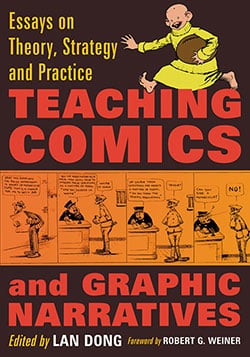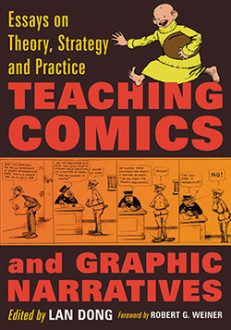Teaching Comics and Graphic Narratives
Essays on Theory, Strategy and Practice
$39.95
In stock
About the Book
The essays in this collection discuss how comics and graphic narratives can be useful primary texts and learning tools in college and university classes across different disciplines. There are six sections: American Studies, Ethnic Studies, Women’s and Gender Studies, Cultural Studies, Genre Studies, and Composition, Rhetoric and Communication. With a combination of practical and theoretical investigations, the book brings together discussions among teacher-scholars to advance the scholarship on teaching comics and graphic narratives—and provides scholars with useful references, critical approaches, and particular case studies.
About the Author(s)
Bibliographic Details
Edited by Lan Dong
Format: softcover (7 x 10)
Pages: 280
Bibliographic Info: 42 photos, notes, bibliographies, index
Copyright Date: 2012
pISBN: 978-0-7864-6146-2
eISBN: 978-0-7864-9264-0
Imprint: McFarland
Table of Contents
Acknowledgments v
Foreword by Robert G. Weiner 1
Introduction: Reading and Teaching Graphic Narratives
LAN DONG 5
Part I : American Studies 11
1. Art and Commerce in the Classroom: Teaching an American Studies Course in Comics
EDWARD A. SHANNON 11
2. The Black Politics of Newspaper Comic Strips: Teaching Aaron McGruder’s The Boondocks and Keith Knight’s The K Chronicles
DANIEL STEIN 26
3. Teaching the Comics Anthology: The Readers, Authors, and Media of McSweeney’s 13
ALEXANDER STARRE 40
4. Teaching Visual Literacy Through 9/11 Graphic Narratives
CHRISTINA MEYER 53
Part II : Ethnic Studies 67
5. Drawing Attention: Comics as a Means of Approaching U.S. Cultural Diversity
DEREK PARKER ROYAL 67
6. Teaching Asian American Graphic Narratives in a “Post-Race” Era
ANNE CONG-HUYEN and CAROLINE KYUNGAH HONG 80
7. Graphic Multiculturalism: Miné Okubo’s Citizen 13660 in the Literature Classroom
JESSICA KNIGHT 94
Part III : Women’s and Gender Studies 105
8. “The Slippage Between Seeing and Saying”: Getting a Life in Alison Bechdel’s Fun Home
SUSAN R. VAN DYNE 105
9. Our Graphics, Ourselves: Graphic Narratives and the Gender Studies Classroom
M. CATHERINE JONET 119
10. Performing the Veil: Gender and Resistance in Marjane Satrapi’s Persepolis and Shirin Neshat’s Photography
JUDITH RICHARDS and CYNTHIA M. WILLIAMS 130
Part IV : Cultural Studies 145
11. The Weimar Republic Redux: Multiperspectival History in Jason Lutes’ Berlin City of Stones
JOSHUA KAVALOSKI 145
12. Ivorian Bonus: Teaching Abouet and Oubrerie’s Aya
SUSANNA HOENESS-KRUPSAW 161
13. Digging Up the Dirt? Teaching Graphic Narratives in German Academia
STEFAN HOEPPNER 173
Part V : Genre Studies 185
14. Making the Unseen and the Unspoken Visible and Audible: Trauma and the Graphic Novel
EDWARD BRUNNER 185
15. Exposition and Disquisition: Nonfiction Graphic Narratives and Comics Theory in the Literature Classroom
ADRIELLE ANNA MITCHELL 198
16. Serial Self-Portraits: Framing Student Conversations About Graphic Memoir
JONATHAN D’AMORE 210
Part VI : Composition, Rhetoric, and Communication 221
17. Batman Returns (to Class): Graphic Narratives and the Syncretic Classroom
KATHARINE POLAK MACDONALD 221
18. 300 Ways to Teach the Epic
MARY ANN TOBIN 232
19. Comics (as) Journalism: Teaching Joe Sacco’s Palestine to Media Students
ALLA GADASSIK AND SARAH HENSTRA 243
About the Contributors 261
Index 265





